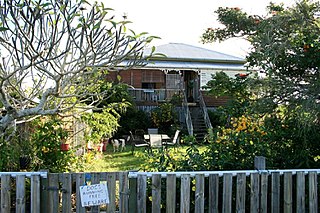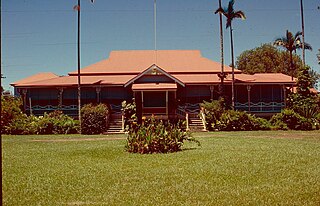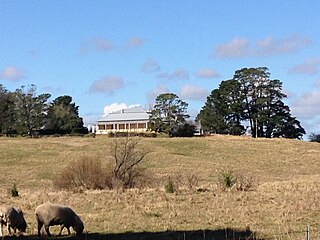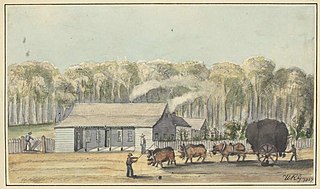
Lismore is a city located in the Northern Rivers region of New South Wales, Australia and the main population centre in the City of Lismore local government area, it is also a regional centre in the Northern Rivers region of the state. Lismore is 734 km (456 mi) north of Sydney and 200 km (120 mi) south of Brisbane. It is situated on a low floodplain on the banks of the Wilsons River near the latter's junction with Leycester Creek, both tributaries of the Richmond River which enters the Pacific Ocean at Ballina, 30 km (19 mi) to the east.

Experiment Farm Cottage is a heritage-listed former farm and residence and now house museum at 9 Ruse Street, Harris Park, City of Parramatta, Sydney, Australia. It is one of Australia's oldest standing residences, being built in c. 1834. It is located at the site of Experiment Farm, Australia's first European farmstead, which was itself created by Australia's first land grant. It was added to the New South Wales State Heritage Register on 2 April 1999.

Elizabeth Farm is a historic estate located at 70 Alice Street, Rosehill, a suburb of Sydney, New South Wales, Australia. Elizabeth Farm was the family home of wool pioneers John and Elizabeth Macarthur. The estate was commenced in 1793 on a slight hill overlooking the upper reaches of Parramatta River, 23 kilometres (14 mi) west of Sydney Cove. The Burramattagal clan of the Dharug people are the traditional custodians of the area; their presence is recalled in the name Parramatta.

Alstonville is a town in northern New South Wales, Australia, part of the region known as the Northern Rivers. Alstonville is on the Bruxner Highway between the town of Ballina and city of Lismore. The village of Wollongbar is 4 km to the west of Alstonville. Alstonville is the service centre of the area known as the Alstonville Plateau.

Ormiston House Estate is a heritage-listed plantation at Wellington Street, Ormiston, City of Redland, Queensland, Australia. It was built from c. 1858 to c. 1865. It was added to the Queensland Heritage Register on 21 October 1992.

Glengallan Homestead is a heritage-listed homestead on the New England Highway, Glengallan, Southern Downs Region, Queensland, Australia. It was built from 1864 to 1904. It is also known as Glengallan Head Station. It was added to the Queensland Heritage Register on 21 October 1992 and is open to the public.

Monsildale Homestead is a heritage-listed homestead at 2532 Monsildale Road, Monsildale, Somerset Region, Queensland, Australia. It was added to the Queensland Heritage Register on 3 April 2009.

Colonsay Farm is a heritage-listed farm at 125 Doolong Road, Kawungan, Fraser Coast Region, Queensland, Australia. It was built in 1909. It is also known as Doolong Farm. It was added to the Queensland Heritage Register on 11 March 2011.

Greenmount Homestead is a heritage-listed homestead at Greenmount Road, Walkerston, Mackay Region, Queensland, Australia. It was designed by William Sykes and built in 1915 by Arthur Carter & Co. It was added to the Queensland Heritage Register on 6 September 1993.
Mountain House is a heritage-listed former teachers residence and school room and now residence at Raglan Street, Wingen, Upper Hunter Shire, New South Wales, Australia. It was designed by William Kemp, the Department of Education architect. It is also known as Wingen Public School. It was added to the New South Wales State Heritage Register on 2 April 1999.

Gundayne House is a heritage-listed residence at 9 Lowes Lane, off The Bucketts Way, Booral, Mid-Coast Council, New South Wales, Australia. It was built by stonemason Sam Carnell. It was added to the New South Wales State Heritage Register on 2 April 1999.
Toongla is a heritage-listed former residence and dairy farm and now residence at 41 Tullimbar Road, Albion Park in the City of Shellharbour local government area in the Illawarra region of New South Wales, Australia. It was built during 1873. The property is privately owned. It was added to the New South Wales State Heritage Register on 2 April 1999.
Little Milton is a heritage-listed residence at 31–33 Smith Street, Wollongong, City of Wollongong, New South Wales, Australia. It was built from 1830 to 1850. It was added to the New South Wales State Heritage Register on 2 April 1999.

Broughton House is a heritage-listed former residence, school and now nursing home at 43a Thomas Street, Parramatta, Sydney, New South Wales, Australia. It was built from 1838 and was possibly designed by John Verge. It has also been known as Newlands, Bowden House, Parramatta Convalescent Home and Parramatta Nursing Home. It was added to the New South Wales State Heritage Register on 1 October 1999.

Glenfield Farm is a heritage-listed homestead at 88 Leacocks Lane, Casula, City of Liverpool, New South Wales, Australia. It was built from 1810 to 1817 by convict labour. It was added to the New South Wales State Heritage Register on 2 April 1999.

Throsby Park is a heritage-listed homestead at Church Road, Moss Vale, Wingecarribee Shire, New South Wales, Australia. It was built from 1820 to 1836. The property is owned by the Historic Houses Trust of New South Wales, but is leased to banker Tim Throsby of Barclays, a descendant of the original owners. It was added to the New South Wales State Heritage Register on 2 April 1999.

The Hassall and Jefferis Cottages are a heritage-listed former inn, coach staging post and children's home dormitory and now residence at Old South Road, Mittagong, Wingecarribee Shire, New South Wales, Australia. It was built from 1827 to 1842 by George Cutter and William Sherwin. It is also known as Cutter's Inn and Cottage No. 8 and Cottage No. 11. It is a surviving feature of the institution variously known as the Mittagong Training School for Boys and Mittagong Farm Home, State Ward Home or Children's Home, although it predated the facility. It was added to the New South Wales State Heritage Register on 2 April 1999.

Epping Forest is a heritage-listed former farm and residence and now vacant building at Mississippi Crescent, Kearns, City of Campbelltown, New South Wales, Australia. It was designed and built from 1825. The property is privately owned. It was added to the New South Wales State Heritage Register on 13 August 1999.
Glenmore is a heritage-listed former farm, vineyard, rural residence and private school and now golf club and function centre located at 754-760 Mulgoa Road in the western Sydney suburb of Mulgoa in the City of Penrith local government area of New South Wales, Australia. It was built from 1809 to 1868. It is also known as Glenmore Heritage Valley Golf and Country Club. The property is privately owned. It was added to the New South Wales State Heritage Register on 2 April 1999.

65 Windmill Street, Millers Point is a heritage-listed boarding house and former residence located at 65 Windmill Street, in the inner city Sydney suburb of Millers Point in the City of Sydney local government area of New South Wales, Australia. The property was added to the New South Wales State Heritage Register on 2 April 1999.



















